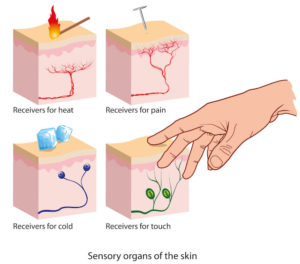It’s got you covered: what makes your skin special?
When thinking about ourselves, we rarely pay attention to our outer layer. Nevertheless, skin is an integral part of the body. So let’s talk about its secrets.
This is a short version, the full version read in Nerdish app.

Skin is the all-important organ
So, which organ, do you think, takes up the most space? Which is the heaviest? Chances are, you might have overlooked this organ when looking inside. After all, your skin is on the border between you and the world outside—or, more precisely, it is the border.
For example, our brain weighs about 1400 grams (a little more than 3 pounds). The liver is about 1500 grams. If we look at only internal organs, they are among the largest.
However, skin beats them both combined: even if we take only its two upper layers, without the fatty tissue beneath them, it weighs about 3–4 kg (6 to 9 pounds). If we include the fatty layer (the subcutaneous tissue), the average weight of human skin goes up to 20 pounds—that is, 15% of the body. The surface area of an average person’s skin is 1.5–2 square meters (around 20 sq. feet). You might think that’s the largest area of a human organ—but the inside of the small intestine is 20 times larger than that.
So, do our bodies use 15% of their weight only to keep other organs inside? Of course not: there are many functions of the skin. Let’s recap the most prominent ones:
- Protection: keeping the insides in, serving as a barrier for damage and microorganisms.
- Sensation: reacting to heat and cold, touch, and vibration and relaying this information to the brain.
- Temperature regulation: skin has more blood vessels than it needs to support itself; dilating or constricting the vessels controls the heat loss.
- Control of fluid evaporation and excretion of metabolic waste.
- Aesthetics and social communication.
Our skin literally defines who we are. So let’s talk here about different sides of it: how it helps us perceive the world (and what can go wrong in this regard), what it is made of, and how to take care of it.
Our interface with the world
Skin is vital in how you sense the world. Many of its structures are part of the nervous system. On the outside, there are sensory receptors. These receptors are responsible for receiving stimuli from the environment and sending them to your brain.
Also called corpuscles, receptors detect all the various sensations that are associated with touch—they are most concentrated in thick hairless skin such as fingertips or lips (that is why these parts of your body are so sensitive). Tactile corpuscles send you signals of light touches: for example when the tag on your T-Shirt is scratching your back. Lamellar corpuscles register pressure—like when someone puts a hand on your shoulder.

5 million hair follicles cover almost the entire body—except the soles of our feet and the palms. Only about 150 000 of them are on the scalp. These follicles also have receptors.
So, the skin is loaded with receptors and plays a big role in the sensory exploration of the world. Its large surface provides the brain with information.
But certainly, some of us have more sensitive skin than others. There are several factors that affect the sensitivity of the skin:
- irritants and allergies, immune responses, etc
- lack of proper moisture (dry skin will be a weaker barrier)
- neural responses (your brain may overreact to stimuli, or the nerves might be more sensitive themselves)
What is the skin made of?
Skin is made of three layers. Each one consists of different types of cells and has its own job to do. In some places, skin can be as thin as 0.5 millimeters (for example, in the eyelids)—or as thick as 4 millimeters (in the soles of the feet). It means that there are different amounts of skin cells on different body parts.

Epidermis is the layer that you can actually see most of the time—and the reason why skin is intact. It is made mostly of stratified flaky epithelial tissue, which is completely replaced every 4 weeks. As new cells form at the base of epidermis, the older ones are pushed up. When they reach the surface, the cells form a tight layer, which protects epidermis from microbes. If any microbes are persistent enough to get deeper, they will be identified and defeated by the immune cells.
Dermis is the layer of the skin that does the most work-related functions of the whole body: sweating, blood circulating, transmitting nerve signals.
Dermal layer consists mostly of collagen—the protein that makes connective tissue. Collagen is flexible, it absorbs shock and pressure well. The more collagen you have, the more flexible your skin is. This protein is produced naturally, however it can be received from food. As we age, our bodies produce less collagen, and the skin gets wrinkled.
